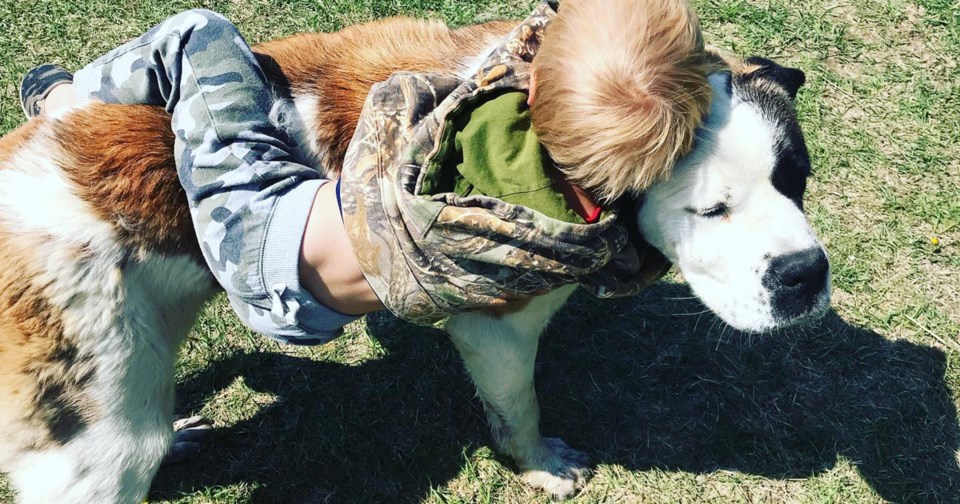HUMBOLDT — As a pet owner, there’s no worse feeling than not having your dog to greet you at home at the end of the day.
For Virginia Bells, that was her family’s reality on Dec. 18 when their one-year-old St. Bernard, Gord, was missing from their farm near Humboldt. Gord was later found in an illegally placed snare near their yard.
According to the Saskatchewan Wildlife Act and Saskatchewan Wildlife Regulations, snares must not be placed within 500 metres of a building, stockade or corral and every resident within one mile of the snare must be notified of its placement. Similar to hunting, trappers also must get permission from landowners before placing snares.
Sgt. Daryl Minter, spokesperson with the environment ministry’s Conservation Officer Service, said they receive complaints regarding snares, often because rules were not followed.
Trapping and hunting laws are clearly stated and discussed when trappers receive their mandatory trappers license, Minter said. The rules and regulations are also in the Hunters’ and Trappers’ guide that is released annually by the provincial government and is freely available online.
In the case of the Bells family, Gord was discovered in a snare that was only 460 metres from their home and they received no notification that the snare was being placed near their yard.
Bells’ husband was the one that found their beloved dog, his injuries were so severe that he wouldn’t let his wife look at the dog. It was clear from his injuries that Gord bled out quickly and did not suffer for long.
“No one should have to see that of their family pet,” Bells said.
Bells has since spoke out against illegal snaring online and will be speaking with her local RM representatives, MLA and MP regarding the lack of communication between trappers and residents.
Bells said she enjoys the outdoors and understands the benefits of trapping in Saskatchewan, especially when it is used to control the coyote population. However, going through this experience and talking with others, Bells has discovered many more pet owners who have lost their pets to snaring, from neighbours to family members.
More needs to be done, she said.
“I’d like to see [trappers] take our opinions into consideration and I would like more trappers to be more aware of what the laws are. Obviously there are some out there that are careless.”
Wrangler Hamm, the president of the Saskatchewan Trappers Association, said he doesn’t like to hear stories of illegal trapping. He said better communication is also the goal of the association but the practices in place are sound and standard with most trappers adhering to the rules.
In the case of Gord, this was an exception that does not help other trappers build relationships with the public, he said. As association president, his goals are the same as Bells; raise awareness regarding illegal trapping and build relationship between trappers and their neighbours.
”We have to ensure relationships are in good standing,” Hamm said, but “it takes responsibility from both the trappers and the public themselves as well to ensure lasting relationships moving forward.”
The trapper involved in Gord’s case has been found and charged but that doesn’t make the situation any easier for Bells and her family. She said she knows the trapper just made a horrible mistake and did not mean to trap Gord but for her children, and even Dolly, Gord’s doggy girlfriend, it is hard losing such a loyal and lovable pet.
Bells has since received online backlash for speaking out against illegal trapping on Facebook and to the media, again not making the situation any easier.
Comments on Facebook pointed the finger at Bells for being an irresponsible pet owner rather than acknowledging the fact that the snare was illegally placed. Bells assumes it was because some people only read headlines instead of the full story since many of the accusations again make the assumption that Gord just wandered away from the yard.
While Bells said Gord had previously had a tendency to wander, she and her husband had solved that problem by installing invisible fencing. Gord was staying especially close to the farm since Dolly just recently had puppies, but Bells said dead pigs used to bait the snare drew him away from their home.
Hamm has seen compromise between trappers and landowners before so he knows that the two parties working together is not impossible. Bells has discussed snare placement with other local trappers and her experiences have been mixed. Not all the local trappers take her concerns seriously, she said.
Helping trappers understand the importance of this relationship building, as well as educating the public, will be a strategy for the association in the future, Hamm said.
“It comes down to open discussion and some give and take and understanding that pets are like our family.”
Open dialogue about snare use is always welcome, he says, and anyone with questions or concerns can contact him directly through the Saskatchewan Trappers Association website.
The Hunters’ and Trappers’ Guide is available to the public through the provincial government website at saskatchewan.ca/hunting, which is also a helpful resource on trapping and hunting requirements for the province.



